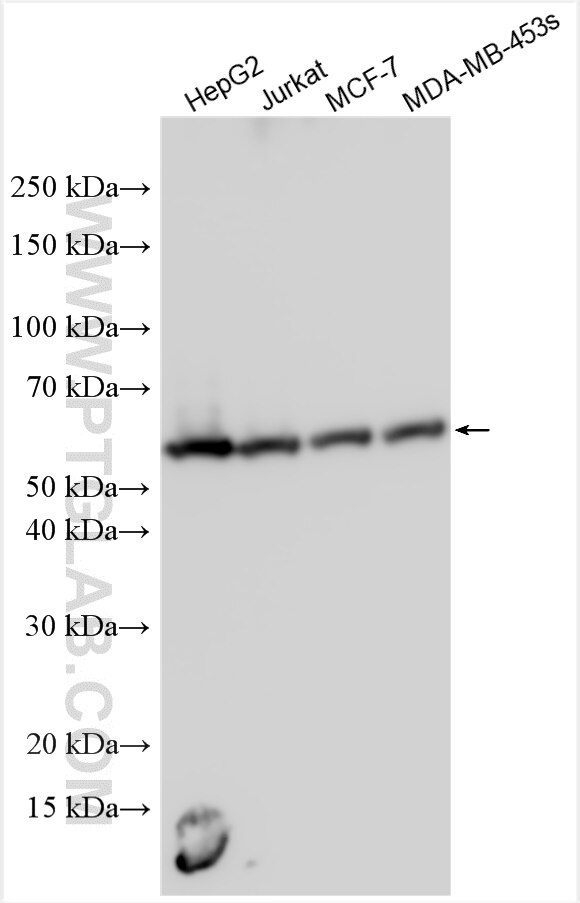JMJD5 Polyklonaler Antikörper
JMJD5 Polyklonal Antikörper für WB, ELISA
Wirt / Isotyp
Kaninchen / IgG
Getestete Reaktivität
human
Anwendung
WB, ELISA
Konjugation
Unkonjugiert
Kat-Nr. : 20999-1-AP
Synonyme
Galerie der Validierungsdaten
Geprüfte Anwendungen
| Erfolgreiche Detektion in WB | HepG2-Zellen, Jurkat-Zellen, MCF-7-Zellen, MDA-MB-453s-Zellen |
Empfohlene Verdünnung
| Anwendung | Verdünnung |
|---|---|
| Western Blot (WB) | WB : 1:500-1:1000 |
| It is recommended that this reagent should be titrated in each testing system to obtain optimal results. | |
| Sample-dependent, check data in validation data gallery | |
Produktinformation
20999-1-AP bindet in WB, ELISA JMJD5 und zeigt Reaktivität mit human
| Getestete Reaktivität | human |
| Wirt / Isotyp | Kaninchen / IgG |
| Klonalität | Polyklonal |
| Typ | Antikörper |
| Immunogen | JMJD5 fusion protein Ag15115 |
| Vollständiger Name | jumonji domain containing 5 |
| Berechnetes Molekulargewicht | 416 aa, 47 kDa |
| Beobachtetes Molekulargewicht | 50-60 kDa |
| GenBank-Zugangsnummer | BC027911 |
| Gene symbol | JMJD5 |
| Gene ID (NCBI) | 79831 |
| Konjugation | Unkonjugiert |
| Form | Liquid |
| Reinigungsmethode | Antigen-Affinitätsreinigung |
| Lagerungspuffer | PBS mit 0.02% Natriumazid und 50% Glycerin pH 7.3. |
| Lagerungsbedingungen | Bei -20°C lagern. Nach dem Versand ein Jahr lang stabil Aliquotieren ist bei -20oC Lagerung nicht notwendig. 20ul Größen enthalten 0,1% BSA. |
Hintergrundinformationen
JmjC (Jumonji-C) domain-containing 5 (JMJD5) (also called KDM8) is a 2-oxoglutarate (2-OG) dependent oxygenase of the JmjC subfamily. By shuttling between the nucleus and cytoplasm, JMJD5 could either associate with histones or cytosolic proteins, and thus plays an important role in embryonic development (PMID:22241836;22402282), circadian regulation (PMID:21115819), osteoclastogenesis (PMID:22375008), and stem-cell renewal (PMID:24740926).
Protokolle
| Produktspezifische Protokolle | |
|---|---|
| WB protocol for JMJD5 antibody 20999-1-AP | Protokoll herunterladen |
| Standard-Protokolle | |
|---|---|
| Klicken Sie hier, um unsere Standardprotokolle anzuzeigen |


